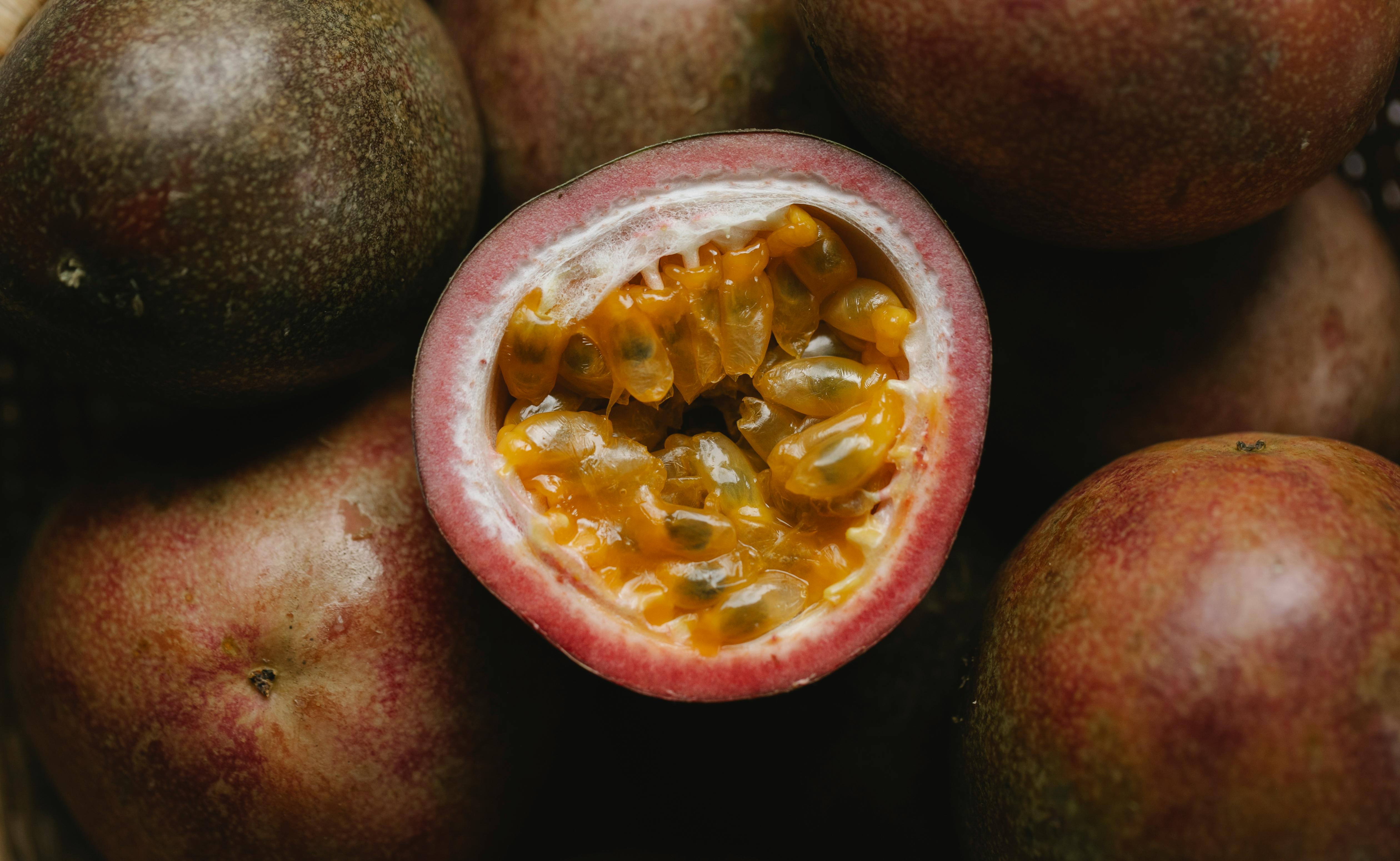Appearance
Ripe passion fruit have a wrinkled, dimpled exterior that is usually a deep yellow or purple in color. The flesh inside is filled with small, edible seeds and has a sweet and tart flavor. The size of the fruit can range from small to large, depending on the variety.Nutrition
Passion fruit is an excellent source of antioxidants, vitamins A and C, dietary fiber, and minerals like potassium and iron. It also contains a good amount of B vitamins and magnesium. The seeds are rich in omega-3 fatty acids, which are beneficial for heart health.Uses
Ripe passion fruit can be eaten raw or used in cooking and baking. It can be used to make jams, jellies, sauces, marinades, smoothies, juices, ice creams, sorbets, cakes and pies. It can also be used as an ingredient in salad dressings or used to top desserts. Passion fruit can also be blended into drinks or included in savory dishes such as curries or stews.Storage
Ripe passion fruit should be stored at room temperature and consumed within a few days of purchase for best flavor. Unripe passion fruits can be stored at room temperature until they become ripe. Once ripe they must be refrigerated immediately or consumed right away for the best flavor.How Can Proper Storage Affect the Appearance of Ripe Passion Fruit?
Proper storage plays a crucial role in maintaining the vibrant appearance of ripe passion fruit. When stored correctly using the best methods for storing passion fruit, such as keeping them in a cool, dry place or refrigerating them, the fruit’s color and texture can remain appealing for a longer period, enhancing its allure.
Color of Ripe Passion Fruit
The color of ripe passion fruit can vary depending on the variety. Generally, ripe passion fruit is deep yellow or golden in color. However, some varieties may also be purple or even dark red when ripe. The edible pulp inside a ripe passion fruit is usually a vibrant orange-yellow, and its taste is both sweet and tart. Passion fruit also has a unique aroma that is both sweet and floral.Ripe passion fruits are ready to eat when they are soft to the touch, but they can be stored in the refrigerator for up to two weeks if needed. To maximize their flavor, it’s best to let them sit at room temperature until they are soft and fragrant before consuming them. Passion fruits can be eaten raw, juiced, or used in desserts or savory recipes.
Shape of Ripe Passion Fruit
The shape of ripe passion fruit can vary from round to oval. It is usually around the size of a lemon. The exterior of the fruit is covered with a thick, waxy purple-brown skin that has numerous small bumps running across it. Inside, the flesh is divided into sections, each filled with juice and hundreds of small seeds. The flavor is tart and sweet at the same time, and it has a pulpy texture.Passion fruit can be eaten raw or used in recipes like juices, smoothies, desserts, cakes, and sauces. It’s also used to make jams and drinks like caipirinha and sorbet. When selecting passion fruit at the store or market look for fruits that are heavy for their size and have smooth skin without any bruises or cuts. Avoid fruits that have brown spots on them or are overly soft or wrinkled as they are likely to be overripe.When storing passion fruits at home keep them in a cool place away from direct sunlight as they can quickly become overripe if left out in the sun for too long. To get maximum flavor out of the fruit you should wait until it’s fully ripe before eating it as this will give you the best taste experience possible.
Texture of Ripe Passion Fruit
Ripe passion fruit has a unique texture that can be enjoyed in a variety of ways. On the outside, the skin is soft and pliable, making it easy to cut and peel away. Underneath, the interior of the fruit is filled with small edible seeds that are surrounded by a juicy pulp. The pulp has a smooth, creamy texture that is slightly sour and sweet at the same time. When eaten raw, the seeds provide an added crunchy texture that is both delightful and satisfying.The texture of ripe passion fruit can also be experienced in various cooked dishes. In desserts such as pies or tarts, its juice can be used to add both flavor and sweetness while its pulp can give pies a thick filling with a burst of flavor when bitten into. In savory dishes such as sauces or salads, its tartness adds depth and complexity to any dish while still retaining its signature creamy texture.
Ripe passion fruit is highly versatile and adds an unmistakable taste to any dish whether cooked or raw. Its unique combination of textures make it a great addition to many recipes, adding sweetness, tartness, crunchiness, and creaminess all at once!

Size of Ripe Passion Fruit
Ripe passion fruit typically range from 3-8 cm in diameter. The size of the fruit depends on the variety and growing conditions. Generally, larger fruits are sweeter and more flavorful than smaller fruits. The skin color also indicates when the passion fruit is ripe—it should be a purplish or yellowish color, depending on the variety. The skin should also be slightly wrinkled, indicating it’s ready to eat. After cutting it open, you can tell if it’s ripe by looking at the pulp inside; the seeds should be surrounded by a juicy, bright yellow or orange flesh. If you don’t find this, then the fruit isn’t ripe yet.When buying passion fruit from a grocery store or market, size is usually an indication of ripeness, but it’s important to check for other signs of ripeness as well. Smaller-sized passion fruits may still be unripe and not as sweet or flavorful as larger ones that are fully ripe.
A Sweet Aroma of Ripe Passion Fruit
The sweet aroma of ripe passion fruit is a tantalizing scent that can be detected from a distance. Its zesty, exotic flavor is the perfect complement to any meal or snack. The unique flavor of passion fruit comes from its high levels of citric acid and sugars, which give it a slightly tart taste. The bright yellow-orange hue of the ripe fruit also adds to its appeal. Passion fruit is rich in Vitamins A and C, as well as calcium, potassium, and phosphorus. It can be eaten raw or used in a variety of recipes, from desserts to salads. Its versatility makes it a popular choice for home cooks and chefs alike.Passion fruit is an excellent source of antioxidants, which help protect against free radical damage and reduce inflammation in the body. It is also believed to have anti-cancer properties due to its high concentration of certain phytochemicals. In addition, passion fruit contains fiber, which helps lower cholesterol levels and keep the digestive system functioning properly. Furthermore, it contains numerous minerals such as magnesium and zinc that are essential for healthy bones and teeth.
The sweet smell of ripe passion fruit can be enjoyed by simply slicing open the fleshy exterior and taking a whiff of its delightful aroma. This delightful scent can also be experienced through jams, jellies, sauces, smoothies or other recipes that use the fragrant fruit as an ingredient. Whether eaten fresh or cooked into something delicious, the smell of ripe passion fruit will bring out your inner foodie!
A Taste of Ripe Passion Fruit
Passion fruit is a tropical fruit that has become increasingly popular in recent years. It has a unique flavor that is both sweet and tart and can be used to make delicious desserts, drinks, and more. The passion fruit has a distinct taste that varies depending on the ripeness of the fruit. Ripe passion fruit is especially sweet and tart, making it a great addition to many dishes.The flavor of ripe passion fruit is hard to describe but can be described as floral with hints of citrus and berry flavors. The sweetness comes from the high sugar content of the fruit while the tartness comes from the acidity. The color of ripe passion fruit can range from yellow or purple depending on the variety. The texture of the ripe passion fruit is similar to that of a mango – soft, juicy, and slightly fibrous.Ripe passion fruits are highly versatile and can be used in both sweet and savory dishes. For example, they can be used in cakes, muffins, jams, smoothies, and even sauces for savory dishes like chicken or fish. They also pair well with other fruits like mangoes or strawberries for delicious smoothie or juice combinations.Passion fruits are packed with vitamins and minerals that are essential for good health such as vitamin C, iron, potassium, magnesium, phosphorus, zinc and dietary fiber. These vitamins help boost immunity as well as improve digestion and overall health. Additionally, they’re low in calories so they’re great for those looking to shed some pounds without sacrificing flavor or nutrition!Overall ripe passion fruits are an incredibly versatile and nutritious addition to any diet or dish! Their unique flavor profile makes them perfect for adding sweetness and a little bit of zing to any recipe! So next time you’re at the store looking for something different to add to your meal plan – grab some ripe passion fruits!
Conclusion
Ripe passion fruit looks quite different from unripe, having a wrinkled and dimpled texture with an orange to dark purple hue. Its flavor is sweet and tart, and its pulp is filled with crunchy, edible seeds. Passion fruit is incredibly versatile in the kitchen, able to be enjoyed in many different forms such as fresh, frozen, or canned. For a delicious treat, passion fruit can be added to smoothies, desserts, yoghurts and salads.In conclusion, ripe passion fruit has a unique look and taste that is sure to tantalize any palate. It’s a great way to add some flavor and nutrition to your diet. If you’re looking to try something new in the kitchen, give passion fruit a go!



